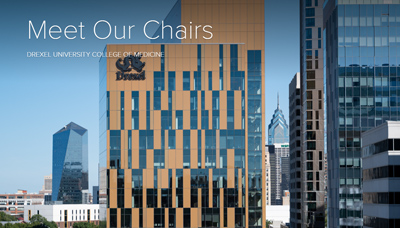Our Faculty
 Drexel University College of Medicine's supportive educational environment emphasizes collaboration and gives students a comfort level that lets them learn and thrive. Our faculty members are respected authors, caring health care practitioners and distinguished scientists who are leading significant breakthroughs in research. They are concerned first and foremost with teaching and helping our students to succeed in their chosen field of study. They share the collaborative spirit that makes Drexel University College of Medicine such a special place.
Drexel University College of Medicine's supportive educational environment emphasizes collaboration and gives students a comfort level that lets them learn and thrive. Our faculty members are respected authors, caring health care practitioners and distinguished scientists who are leading significant breakthroughs in research. They are concerned first and foremost with teaching and helping our students to succeed in their chosen field of study. They share the collaborative spirit that makes Drexel University College of Medicine such a special place.
Please use this searchable directory to find faculty and learn more about them. Learn more about our departments.